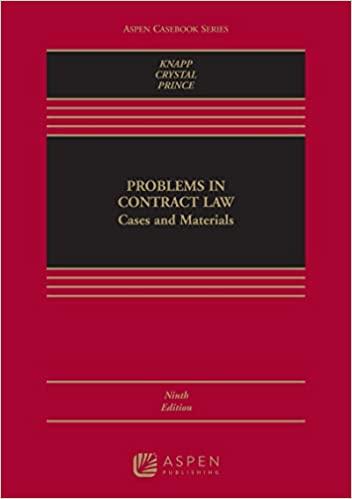Question
Anne Mulcahy & Xerox When Anne Mulcahy became CEO and chairperson of Xerox in 2001, the odds of saving the 'doomed ship' were stacked against
Anne Mulcahy & Xerox
When Anne Mulcahy became CEO and chairperson of Xerox in 2001, the odds of saving the 'doomed ship' were stacked against her.Mulcahy replaced an ousted CEO who had only lasted 13 months on the job. Xerox was teetering on the edge of bankruptcy.
Xerox was one of those rare companies whose brand name became so common in use that the word entered the language as a verb. People didn't 'photocopy' a document, they 'Xeroxed' it. But as with many other megalithic companies, decades of industry dominance led to complacency. Xerox began to lose direction and market share and by2000, had lost $273 million in revenue. By 2001, it had over $17 billion in debt.
In the two years previous to Mulcahy's appointment to CEO at Xerox , not only had the debt ballooned to $19 billion, but they were battling an internal fraud scandal. Customers and employees were quickly walking away. Coupled with a seriously weakening economy,Xerox's last effort to survive saw them sack their CEO of thirteen months and appoint AnneMulcahy - a Xerox employee who been there for nearly her entire career and who had worked in many different divisions. Her thorough knowledge of the company, made her an ideal candidate - and she knew Xerox had lost its way.
Her first task was CEO was to go on a 'listening tour'. Over 90 days she spoke to employees, customers and industry experts across the US on where Xerox had gone wrong. Employees said that they needed clearer goals. Customers said Xerox had lost its responsiveness. Tech gurus said it was investing randomly, rather than focusing on a few markets where it could dominate.
Mulcahy also tackled the huge financial problems facing Xerox. She formed a team of advisors, and focused first on cash generation in order to survive. For three months she relentlessly lobbied the 58 banks who had loan arrangements with Xerox and managed to persuade all to stay with Xerox.
Across the company people became fearful and uneasy. Many had known for a long time that things had to change - but there had been no managerial impetus to do so. During the 1990's Xerox had tried to centralise administration and reorganize its sales force but poorly executed, it had left employees unsure of their roles and sceptical about the company's direction. Trust in the leadership began to wane as decision making became murky, nothing was clear. Everybody in the field knew it wasn't working, but nobody said anything.
Now, to restructure and save the firm, over 22,000 employees were removed. Scrutiny of processes meant that all unprofitable plants were closed. Careful selection meant that only those markets where Xerox had a competitive advantage andopportunities for profitable growth were retained.Mulcahy pointed out: "We couldn't think about what it would cost us in terms of customer relationships, continuity, and trust. We had to look after our people - but we also had to survive as a company. Harsh decisions had to be made - while being as fair to our people as possible".
Mulcahy acted swiftly, she knew that workers needed to feel secure in giving honest, constructive feedback. "The bottom line is that it's all about getting your people aligned around a common set of objectives. They all had to focus on the same goal - we all knew it would be painful. At Xerox, that was the difference between success and failure," she said.
Mulcahy was careful to maintain the strengths of what Xerox had to offer. As a document-management company, it focused on technologies like scanning, imaging and content management and research. It had long been known as an innovator, and Mulcahy insisted that they remain committed to research and development despite the costs.Pivoting towards developing new technology, Xerox was able to expand their focus to market their research capabilities to other companies. Today, about three-quarters of the company'srevenue comes from products and services introduced by Xerox research.
Mulcahy becameknown for her extraordinary leadership and management capabilities. Two years after taking the role of CEO, Xerox was showing$91 million in profits. By 2016, the company's profits had reached $859 million on sales of $15.7 billion.
When questioned on her leadership style, Mulcahy said: "Too many aspiring leaders obsess over other people's ideas of what a leader should be. It's most important to play to your strengths and not to conform to someone else's image of leadership," she said. "It allows you to have integrity of style and consistency of character. I'm very direct. I'm less into management than I am into working with teams and solving problems. So I'm very engaged and involved, but also, I think, work has to be fun. I'm big on, 'It's a job, so lighten up and don't confuse life and work.' I put a lot of energy into my work, but it's still work."
Question
Models of Resistance - what they mean. Select one. Link to successful change and any relevant theory which will support your claims.
Resistance and Ethics and what that can mean. Link to successful change and any relevant theory which will support your claims
Step by Step Solution
There are 3 Steps involved in it
Step: 1

Get Instant Access to Expert-Tailored Solutions
See step-by-step solutions with expert insights and AI powered tools for academic success
Step: 2

Step: 3

Ace Your Homework with AI
Get the answers you need in no time with our AI-driven, step-by-step assistance
Get Started


